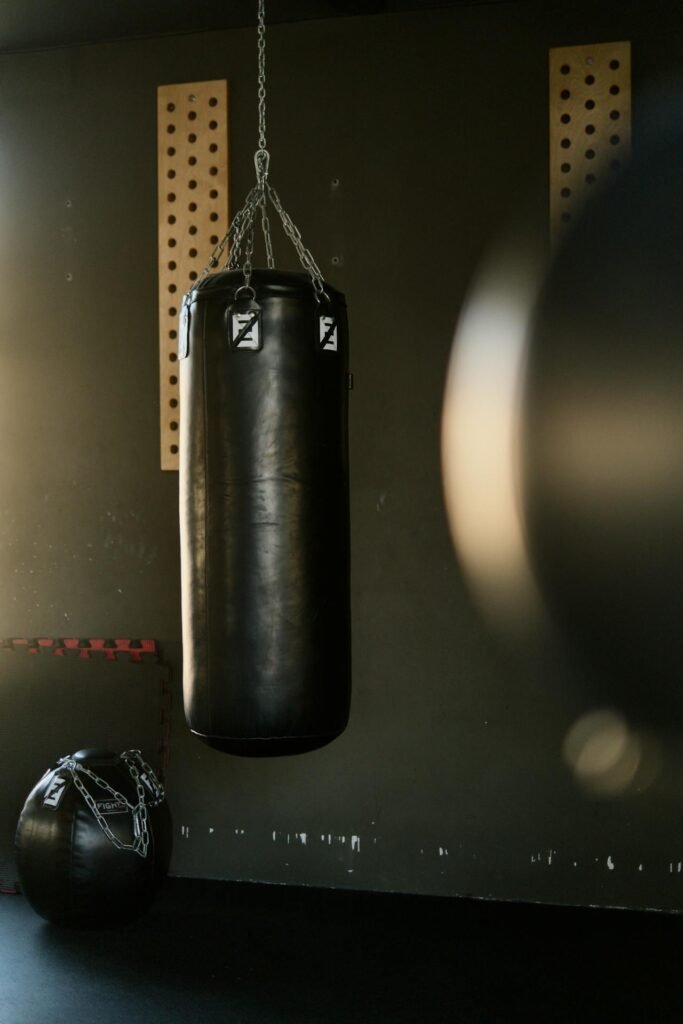If you are new to boxing, exploring heavy bag drills for beginners will be invaluable. The heavy bag is your best training partner, and the drills you perform are crucial for your boxing development. The heavy bag never complains, always shows up, and gives clear feedback on your technique and effort (especially if you record your training!).

Use these beginner friendly drills to build real power, sharper speed, and better endurance without sacrificing form.
Want to learn proper technique for the boxing basics? Take a look at our guides on perfecting the jab and mastering the cross!
Safety and Gear Required Before Starting Heavy Bag Drills
- Wrap your hands every session.
- Wear proper training gloves.
- Keep the area clear so you can step around the bag.
- Breathe on every punch and never hold your breath.
Protect your hands and train smarter. Read our hand wraps guide and our training gloves guide.

Warm Up Routine Before Heavy Bag Drills for Beginners
A proper warm up is essential when boxing, especially before starting heavy bag drills. Skipping this step increases the risk of injuries such as pulled muscles, strains, or even fractures.

Before you launch into powerful punches, spend a few minutes loosening up your body with light movement and stretches. Here is a simple beginner friendly routine too prepare before doing some beginner heavy bag exercises:
- Light bounce in place with gentle shoulder circles.
- Do some light shadowboxing work to get primed.
- Ten slow squats and ten hip hinges.
- Thirty seconds of light taps on the bag to wake up your shoulders.
These exercises will raise your heart rate, loosen your joints, and prepare your muscles for the demands of heavy bag training.
Key Techniques for Heavy Bag Drills
Don’t slack while doing heavy bag drills. Just because the bag can’t fight back doesn’t mean you can lower your guard. Monitoring these things is what separates smart boxers from the rest:
- Stand about one arm’s length from the bag.
- Eyes up and chin tucked.
- Hands return to guard after every punch.
- Step after you finish the combo, not during.

A textbook example of what not to do. Don’t let those hands drop unless that’s what you are planning!
Core Heavy Bag Drills for Beginners
These rounds are guaranteed to get you sweating and working hard. It’s all about technique, with great technique, the speed and power follow. Focus on executing the drills right and not just wailing on the heavy bag with needless heavy punches.
Drill One: Jab Cadence Builder
Time: 60 seconds work, 30 seconds rest
This is one of the most effective heavy bag drills for beginners to develop timing and accuracy. Throw single jabs at a steady, controlled rhythm. After each jab, snap your hand straight back to guard and take a small step to adjust your position.
Focus: Clean mechanics, consistent rhythm, and accuracy over power.

Drill Two: One-Two with Exit
Time: 90 seconds work, 30 seconds rest
Throw a crisp one-two combination (jab then cross) with full extension on both punches into the heavy bag. Immediately after, step to your left or right to get off the centerline, then reset your stance. At beginner level its important to add a slip or head movement during the exit to simulate avoiding a counterpunch.
Focus: Sharp combinations, safe exits, and integrating defence into your offence.

Focus on the clean up after the combination. You should not be standing infant of your opponent within striking range.
Drill Three: Double Jab into Cross
Time: 60 seconds work, 30 seconds rest
Start with a light jab to gauge distance and touch the heavy bag. Step in with a second jab that carries more intent, then immediately drive a strong cross through the target. Finish the combo by stepping or pivoting out to one side to reset.
Focus: Building range control, setting up power shots, and creating safe angles after attacking.
Drill Four: Power Hooks to the Body and Head
Time: 60 seconds work, 30 seconds rest
A great beginner heavy bag drill for short range attacks. Deliver a solid left hook to the body, then follow with a left hook to the head in one smooth motion. If you’re comfortable, repeat the same sequence on the right side. Rotate your hips for power, keep your knees slightly bent, and maintain your opposite hand in guard at all times.
Focus: Developing hip rotation, mixing targets, and maintaining strong defensive positioning.

Dill Five: Uppercut Ladder
Time: 60 seconds work, 30 seconds rest
Start with a single rear uppercut, then reset your stance. Next, throw two uppercuts in a row onto the heavy bag, then reset again. Continue building up until you reach five consecutive uppercuts, then work your way back down to one. Generate power by driving through your legs and rotating your hips, avoid swinging your arms wildly.
Focus: Building explosive power from the legs, improving punch sequencing, and maintaining clean form during repetition.
Drill Six: Four Corner Footwork Circle
Time: 90 seconds work, 30 seconds rest
Visualise the heavy bag as having four distinct sides. Jab the front, step to the side, jab again, and keep circling until you return to your starting point. When you complete a full circle, add a one-two combination before beginning the next rotation. Keep your guard up and maintain light footwork throughout.
Focus: Improving lateral movement, maintaining distance, and integrating punches into controlled footwork patterns.
Drill Seven: Tempo Round
Time: 2 minutes work
Alternate between 10 seconds of rapid-fire punches, keeping your hands moving non-stop, and 20 seconds of lighter, relaxed shots with smooth footwork onto the bag. Continue cycling between these two tempos until the round ends. Keep your breathing steady during the fast bursts and focus on precision during the lighter phases.
Focus: Building stamina, learning to breathe correctly, and switching seamlessly between high-intensity offence and active recovery.

Remember to invest in the body. You don’t have to head-hunt the entire time as the body is always a viable option to target (envisioned on the heavy bag).
Sample thirty minute session
Having a session outline will help you keep all your skills fresh. Try to work all combos and punches often, perfecting a single punch is great until your opponent figures that out and starts capitalising on your limitations. Move out of the beginner zone by growing your arsenal of potential punches.

Here is a basic plan to use that hits a good variety of punches while working the heavy bag:
- Warm up: three minutes
- Drill one and two: two rounds each
- Drill three and four: two rounds each
- Drill seven defense after offense: one round
- Tempo round: one round
- Cooldown: light shadowboxing and stretching for two minutes
Common mistakes and easy fixes
- Pushing the bag instead of snapping punches
- Fix: Imagine your punches like a whip, quick and sharp. Snap them out and let them recoil back to guard instead of shoving the bag.
- Standing still in front of the bag
- Fix: Stay mobile. Take a small step or pivot after every combo to build better footwork and angles.
- Dropping your hands after punching
- Fix: Always return to your guard before moving. Think “punch, recover, move” as one smooth sequence.
- Throwing all power with no rhythm
- Fix: Mix lighter, faster shots with occasional strong punches. This builds endurance and keeps your timing sharp.
Looking to start practising boxing at home? Check out our setup guide for boxing at home and our choice for a reliable heavy bag!
Final Thoughts On Heavy Bag Drills For Beginners
Consistency beats occasional max effort. Keep your form tidy, breathe, and move your feet. As your technique improves, these drills will feel smoother and your power and speed will rise naturally.
Keep recording your sessions to highlight imperfections in your technique. Keep putting the work in with a heavy bag and you will find your boxing improves drastically!

Next reads:
Beginner Guide to Boxing Terminology
How to Stop Flinching and See Punches
How Often Should Beginners Train



